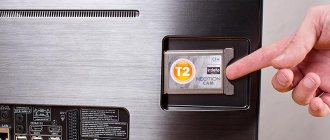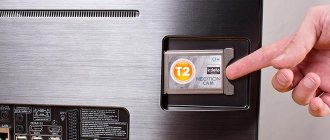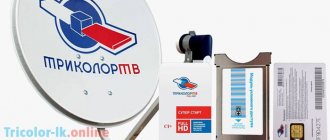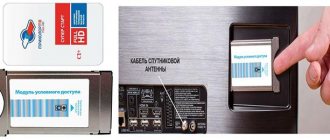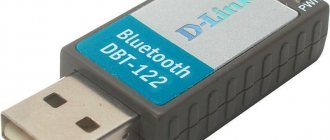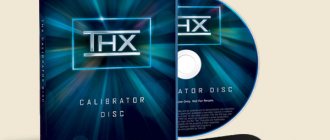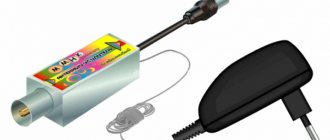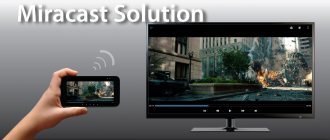To watch free digital channels, you need special equipment - a DVB T2 tuner. It acts as a kind of intermediary between the antenna and the TV, decoding the incoming signal. If there is a need for paid channels, providers offer the purchase of a set-top box, which, in addition to decoding the signal, includes a set of codes for accessing restricted content. But there is also a third, less troublesome option that eliminates bulky third-party peripherals - a cam module for a TV. Let's figure out what it is, what types of devices are found, and how to connect it.
What is a CAM module
Modern Smart TVs are becoming more and more convenient and no longer require connecting auxiliary equipment to broadcast cable or satellite channels.
Built-in tuners accept streaming video and decode various signal formats, but they require assistance to operate. It is provided by the CAM module. To function fully, the device requires a smart card, which can be purchased from your service provider.
By purchasing a TV with a CAM module, the consumer receives a number of additional benefits. Firstly, it saves on price, because you don’t have to buy or rent a receiver from a provider to watch cable or satellite television. Secondly, it is easy to set up.
The device is placed in a special slot on the TV, after which you just need to automatically tune in TV channels. Thirdly, it saves free space that would be required to install a satellite receiver, as well as the absence of unnecessary wires and the need to allocate an additional outlet or connect a surge protector. Fourthly, control is carried out using one remote control from the television receiver. When connecting the receiver there will be two of them.
What is this device
Modern TVs easily receive digital terrestrial channels via a built-in TV tuner. But only free and unencrypted ones, because the receiver does not have the keys needed to unlock paid content.
In addition, TVs from well-known manufacturers - Samsung, LG, Philips, etc. There is no possibility of flashing the built-in tuners, as well as entering encrypted keys through them. The CAM module is needed to decode smart cards and read provider codes . Let's figure out how it works.
Types of CAM modules
CAM modules for TVs come in several types:
- simplest. Works with only one coding system. If the user changes provider or switches to a satellite with a different broadcast system, this device will need to be replaced. Most pay TV channels are broadcast in different encoding systems, so such CAM modules are not able to recognize them;
- most common. Such a device automatically updates and adapts to the required system when a new smart card is connected. If the user has several smart cards from different providers, he will be able to switch between them if he wants to watch certain television channels;
- universal. Flashed and configured for a range of encoding systems and works with various smart cards. Capable of independently setting up TV programs, as well as automatically adjusting signal parameters. Used to work with paid software packages.
What types of CAM modules are there?
CAM adapters are:
- Universal;
- Single-system;
- With the possibility of additional programming functionality.
Single system
A single-system CAM module is designed for only one specific signal encoding system. Many operators provide the CAM module along with a pre-installed card after you subscribe. This system is used by Tricolor, MTS, DomRu companies. In case of concluding an agreement with NTV-plus, the user will be required to install the received card into an empty module.
The CAM adapter can be provided free of charge by the operator or purchased separately by the client. Rostelecom, for example, sold an adapter along with a card for a thousand rubles. If you change service provider, you may need to purchase a different CAM module.
Universal
The universal adapter decrypts encodings for several modular systems at the same time. Such an adapter itself can change the signal and program settings, adapting to the card installed in its slot.
The price range for universal KAM modules ranges from approximately 1,500 to 6,000 rubles. Adapters from 1500 to 3000 rubles are inexpensive, but are already somewhat outdated. Adapters in the range of 5-6 thousand are adapted to modern broadcasting standards and the latest technological advances, so they will be usable longer.
Leave a request and receive a 15% discount on your first repair!
Submit your application
Operating principle of the CAM module
To use the CAM module to broadcast satellite or cable television channels, the user will need to purchase a Smart card from the provider. This is a small plastic card with a microchip that identifies the subscriber and gives him access to digital television and pay TV channels.
It must be inserted into the CAM module and then installed into the television receiver. Next, the user will need to configure the channel list, after which he can start watching.
Installing the CAM module in the TV
Depending on the model of the television receiver, there may be two options for installing the CAM module:
- via CI slot.
- using a special CI adapter.
Attention! Before you buy a CAM module, you should make sure that your television panel can receive uncoded (free) digital channels. If such a broadcast is not provided, then installing the CAM module seems useless.
Algorithm
The installation sequence for the CAM module is the same in all cases and boils down to:
- disconnecting the television receiver from the power supply;
- installing the smart card into the module so that the contact pads of the CHIP are facing the side where the colored label is glued (in this case, the smart card must be inserted all the way);
- connecting the CAM module to the television receiver in accordance with its operating instructions;
- turn on the TV and check the reception of encrypted channels.
Precautionary measures
To ensure the safety and functionality of the CAM module, you must adhere to some recommendations. Thus, rough mechanical influences should be avoided, which could result in damage to the device body and the components inside it. And the installation and connection of modules must be carried out in strict accordance with the instructions supplied with the television receiver. In addition to this you should:
- do not overheat the module;
- do not bend the smart card or store it near sources of strong electromagnetic radiation;
- do not remove the smart card from the module unless absolutely necessary;
- Do not remove the CAM module from the television receiver unless absolutely necessary.
Important! Failure to comply with the above recommendations may result in failure of both the CAM module and the TV.
How to configure the CAM module
To configure the CAM module, no specialist assistance is required. The user can do all connection steps independently if the TV has an appropriate CL slot. Installing the module in a Samsung, LG or other brand TV is exactly the same and looks like this:
- place a smart card in the CAM module. To do this, you need to turn the device facing you and put the card inside, turning it over with the electronic chip facing up;
- disconnect the TV screen from the network and connect the CAM module to the CL slot face up;
- turn on the TV receiver. The display will indicate that new equipment has been installed;
- perform automatic tuning of television channels.
If the steps are completed correctly, the user will be able to start watching TV programs. If after setup there are no channels or nothing happens after turning on the TV receiver, this means that the smart card or CAM module is installed incorrectly. It is recommended to remove them from the connector and reconnect.
CI CAM - what is it?
CAM module
The CI CAM module is installed in the TV so that the user can access paid content in high resolution. These are interesting, rarely seen programs, exclusive news releases, films that are ordered by the provider himself, and so on. The system responsible for decoding digital signals is located in a “smart” card connected to the TV, which reads it using a CAM adapter.
It turns out that the KAM module is an adapter into which cards are inserted that provide access to paid TV channels. Its task is to capture streaming content, decrypt it and send it as a signal to the TV receiver.
To receive a card, a digital television subscriber subscribes by contacting the operator. Each card is assigned its own number. “Keys” are sent to it, allowing temporary access to a paid channel, of which there may be several. Using these keys, the CI module decrypts the signal and broadcasts it to the screen. The lifetime of a key depends on the encryption algorithm.
The card is placed in a slot called the CAM module. For the latter to work, it is inserted into the CI slot. The CI module is an intermediary between the KAM adapter and the TV panel. It can work with one or two cards simultaneously, depending on its type.
Relatively recently, a new interface appeared - CI +, which is technologically more advanced and prevents piracy.
CI module, what is it - from English, Common Interface, a connector with a slot into which cards are inserted that provide access to digital content. What should be in the TV receiver in order to connect a KAM module to it:
- CI slot;
- DVB-C tuner;
- Minimum HD resolution (preferably Full HD and higher).
Connecting a card issued by your provider is no more difficult than installing a microSD memory card in a smartphone
SI CAM module and its advantages:
- saving money. If your TV has a KAM module, you can watch content in high quality without connecting external devices, such as set-top boxes. All you need to do is contact your service provider, select a package and receive a “smart” card;
- easy setup. Connecting a card issued by your provider is no more difficult than installing a microSD memory card in a smartphone. Channels are also set up quickly - in 2 minutes;
- compactness. The CAM module looks like a regular plastic bank card, that is, it is much smaller compared to a digital set-top box, but provides the same capabilities. And using this module, you don’t have to run cables to the TV;
- ease of channel management. To switch them, a regular remote control included in the kit is suitable. You won't need a DVB-T2 remote control.
Broadcast management, archive of broadcasts for 3 days
Beeline TV gives you the opportunity to start watching a program again at any time or watch an already completed program*. You can find it in a search, video directory or TV program and play it. Such transfers will be marked with a special icon. You can also always pause the broadcast and rewind.
*The function of viewing past programs and managing the broadcast is not provided by the copyright holders on all channels.
Subscriptions and video rental
In addition to TV channels, Beeline TV presents a wide selection of films and cartoons from leading Hollywood and Russian studios. All films are presented in HD quality and without advertising. You can purchase a film either for rent or forever. The minimum cost of the film is 99 rubles. The service also offers various subscriptions and collections.
Films purchased for rent are available for viewing for 30 days. You will have 48 hours to complete your viewing. When you purchase a movie, you can watch it at any time, any number of times, without additional payment.
Unified access across all devices
Continue watching where you left off, even on other devices. The service remembers up to what point you watched the film.
Managing connected devices
To connect a new device, you need to enter your number and the received PIN. In total you can connect up to 5 devices. Devices can be removed no more than once every 2 months. For Beeline mobile subscribers, traffic in the application is not charged.
Connection on mobile devices (required Android version 4.3 or later):
- Open Google Play on your device
- Find the Beeline TV application using search and install it
- Open the Beeline TV application on your device and enjoy watching
Connection on iOS mobile devices:
- Open the Apple Store on your device
- Find the Beeline TV application using search and install it
- Open the Beeline TV application on your device and enjoy watching
Parental control
The user can set the parental lock password to:
- purchases of packages and films, contract payment, trust payment, card payment
- viewing adult content
- viewing content above the specified age limit
How the module works
The module, in order for it to work and meet the user's needs, needs a smart card with a microchip. It is purchased from the provider. After installing the card, the subscriber will be identified. It is inserted into the CAM module, and this adapter into the TV. Then the program works independently, automatically reading the keys from the card, decoding the signal in a format understandable for TV. The receiver, configured in this way, delights its user with an excellent, clear picture.
Thanks to such CAM modules, you can have high-quality digital channels. There is another good news, this is that these devices remember and record the signal, doing their processing. The subscriber can play back the recorded information at any time convenient for him.
CAM module
Almost all modern TVs are equipped with additional devices, one of which is a built-in tuner that supports HD Ready or Full HD digital formats. The CAM module is its external support.
The CAM module can be described as a small digital computer. It decorates the digital stream and matches it with the TV model on which it is installed. This mini device has a special card, thanks to which a high-definition digital signal is reproduced. The module is inserted into a special expansion module CI slot.
What to do if you receive the error “There is no CI module in the LG TV”
You can download instructions for setting up a list of TV channels for TVs with a CI module from the provider’s official website. If the user is sure that his device is equipped with a CAM module, but when trying to set up an LG TV, the error “No CI module” appears, then it is recommended to check the selected signal source - the password stored on the Smart card can only be read in the “Cable TV” mode. To avoid repeating the system error, new parameters must be saved into the memory of the television device. A failure may also occur due to an outdated version of the television software.
To update the firmware, the user will need:
- download the latest version of webOS from the official LG website;
- transfer the downloaded file to a USB drive previously formatted in FAT32;
- connect the USB flash drive to the TV and run a manual software update.
When webOS is updated, all that remains is to complete the playlist of pay TV channels. Another solution to the problem is to change the user’s region of location in the TV settings - when editing an account, it is recommended to select “Germany” or “Finland” as the country of residence. It is worth noting that setting a new parameter will not affect the functionality of webOS in any way.
Conclusion
Now the user knows what CAM and CI modules for a TV are. To successfully install a Smart card, you must use only the network parameters proposed by the provider - otherwise the microchip will not be read, and the TB device system will definitely generate an error.
Advantages
New models of television receivers designed for viewing digital channels do not require any additional external devices. It is enough to simply approach the process of installing a satellite dish correctly and connect its cable directly to the TV. In addition to the obvious savings due to the absence of the need to purchase an additional tuner, a TV with a built-in receiver and a slot for the CAM module allows you to get the following advantages:
- ease of installation and configuration;
- saving space;
- ease of control using the remote control.
